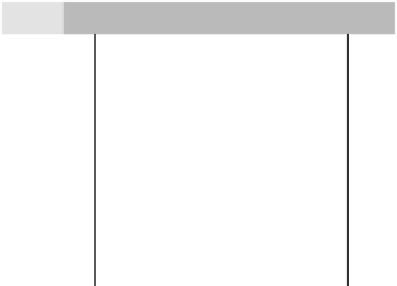Graphics Reference
In-Depth Information
Tabl e 4. 3
Inverse angle parameter
B
as a function of angular parameter
A
A
32
26
21
17
13
9
5
2
B
256
315
390
482
630
910
1638
4096
Fig. 4.6
An example of
projecting left reference
samples to extend the top
reference row. The
bold
arrow
represents the
prediction direction, the
thin
arrows
the reference sample
projections in the case of intra
mode 23 (vertical prediction
with a displacement of
9/32
samples per row).
Reproduced with permission
from [
8
], © 2012 IEEE
ref
Œx
D
pŒ
1
C
xŒ
1 ; .x
0/ for vertical modes
(4.8)
ref
Œy
D
pŒ
1Œ
1
C
y ; .y
0/ for horizontal modes
(4.9)
If angular parameter A is negative for the selected mode, samples from both
left and above of the block are required for the reference array. In these cases
the samples in
ref
[
x
] array with non-negative indexes are populated as described
above. The sample values for negative indexes are obtained by projecting the left
reference column to extend the top reference row towards left, or projecting the top
reference row to extend the left reference column upwards in the case of vertical
and horizontal predictions, respectively. This projection is defined as follows:
ref
Œx
D
pŒ
1Œ
1
C
..x
B
C
128/ >> 8/ ; .x < 0/ for vertical modes
(4.10)
ref
Œy
D
pŒ
1
C
..y
B
C
128/ >> 8 / Œ
1 ; .y < 0/ for horizontal modes
(4.11)
where
B
represents the inverse angle of the angular parameter
A
and is given in
Tab le
4.3
.
Figure
4.6
illustrates extension of the reference row for the vertical prediction
mode 23 with angular parameter
A
equal to
9. In this case, two of the samples in
the left reference column are required in the sample prediction process and projected
to extend the reference array with inverse angle parameter of
910.












































